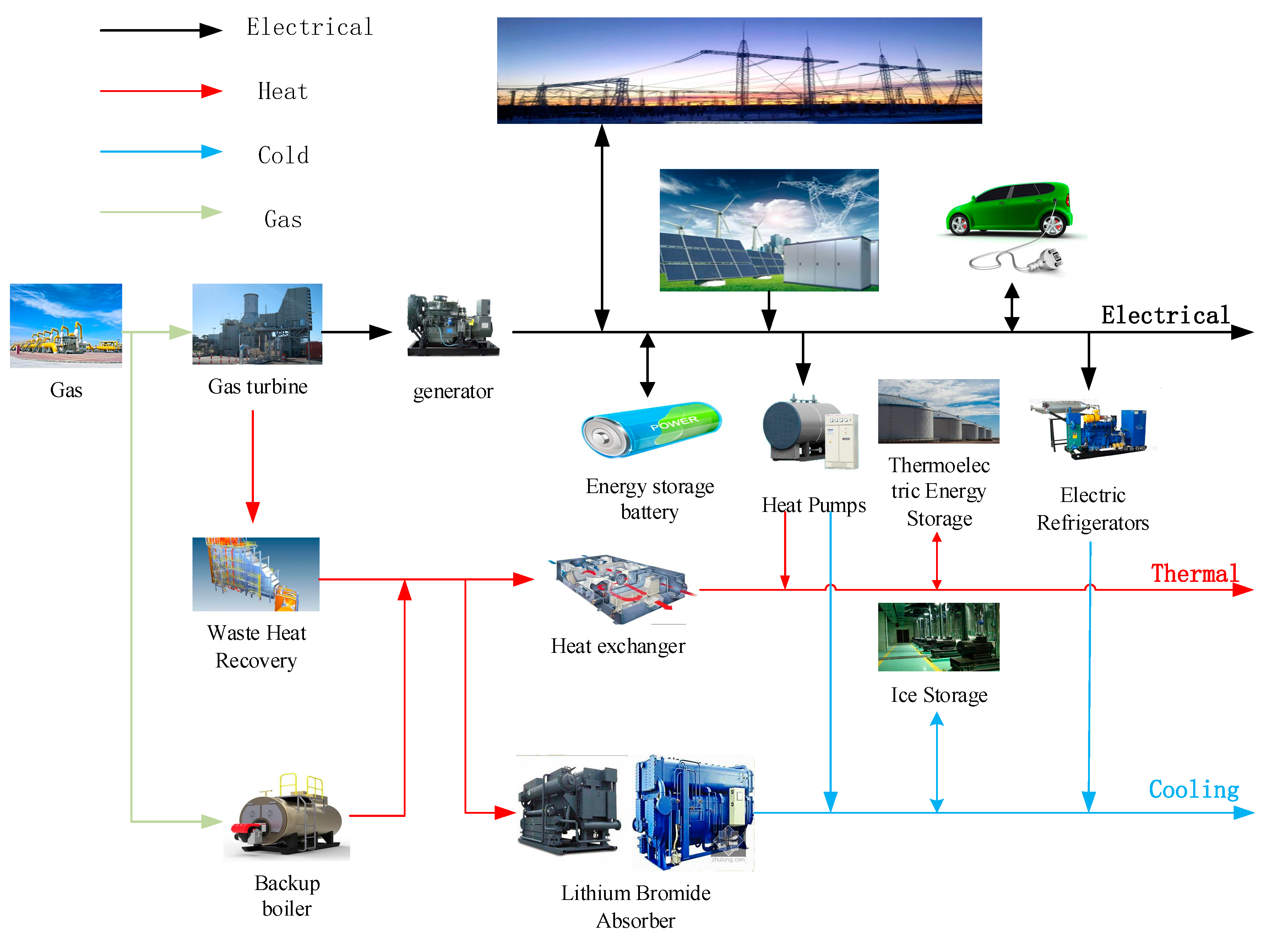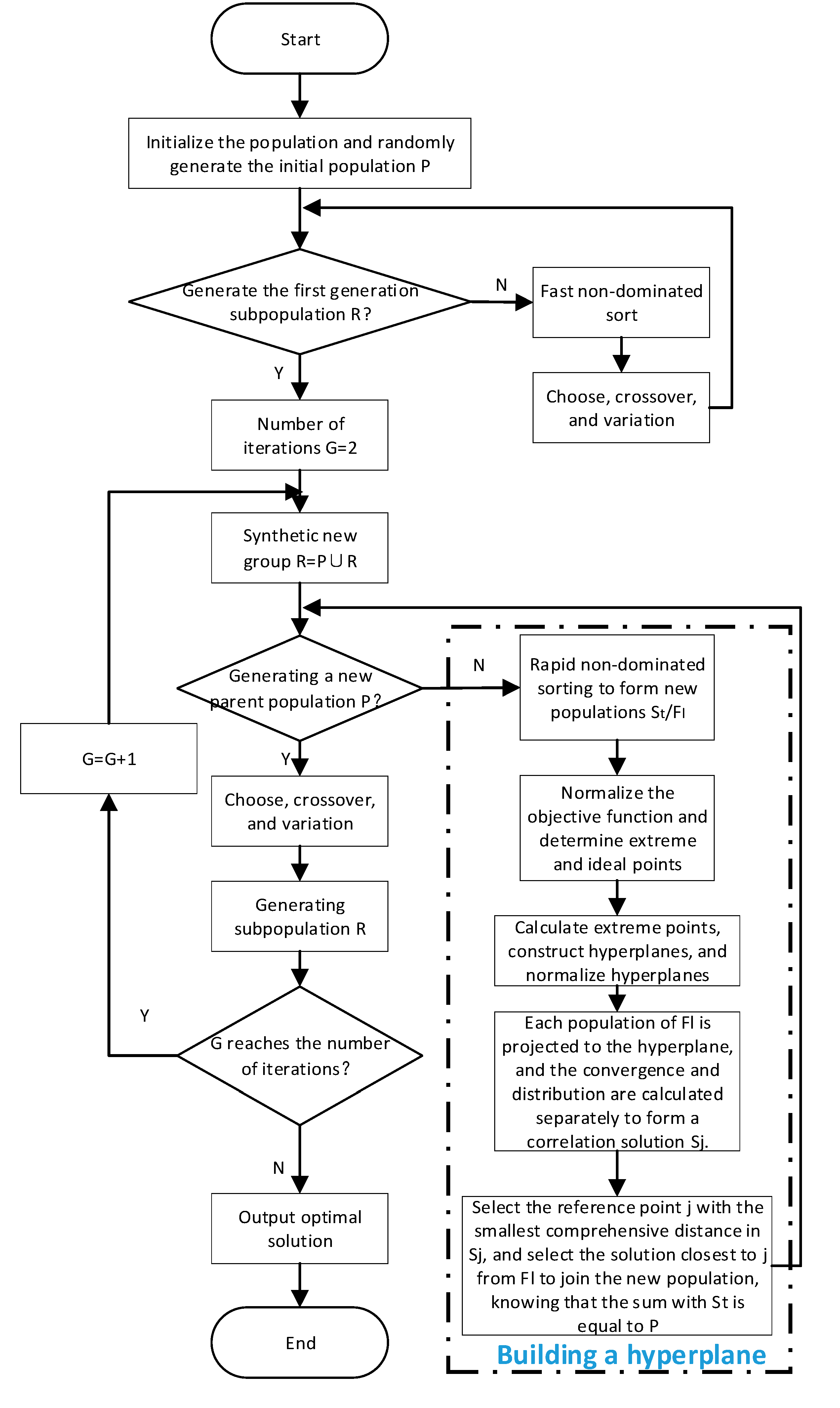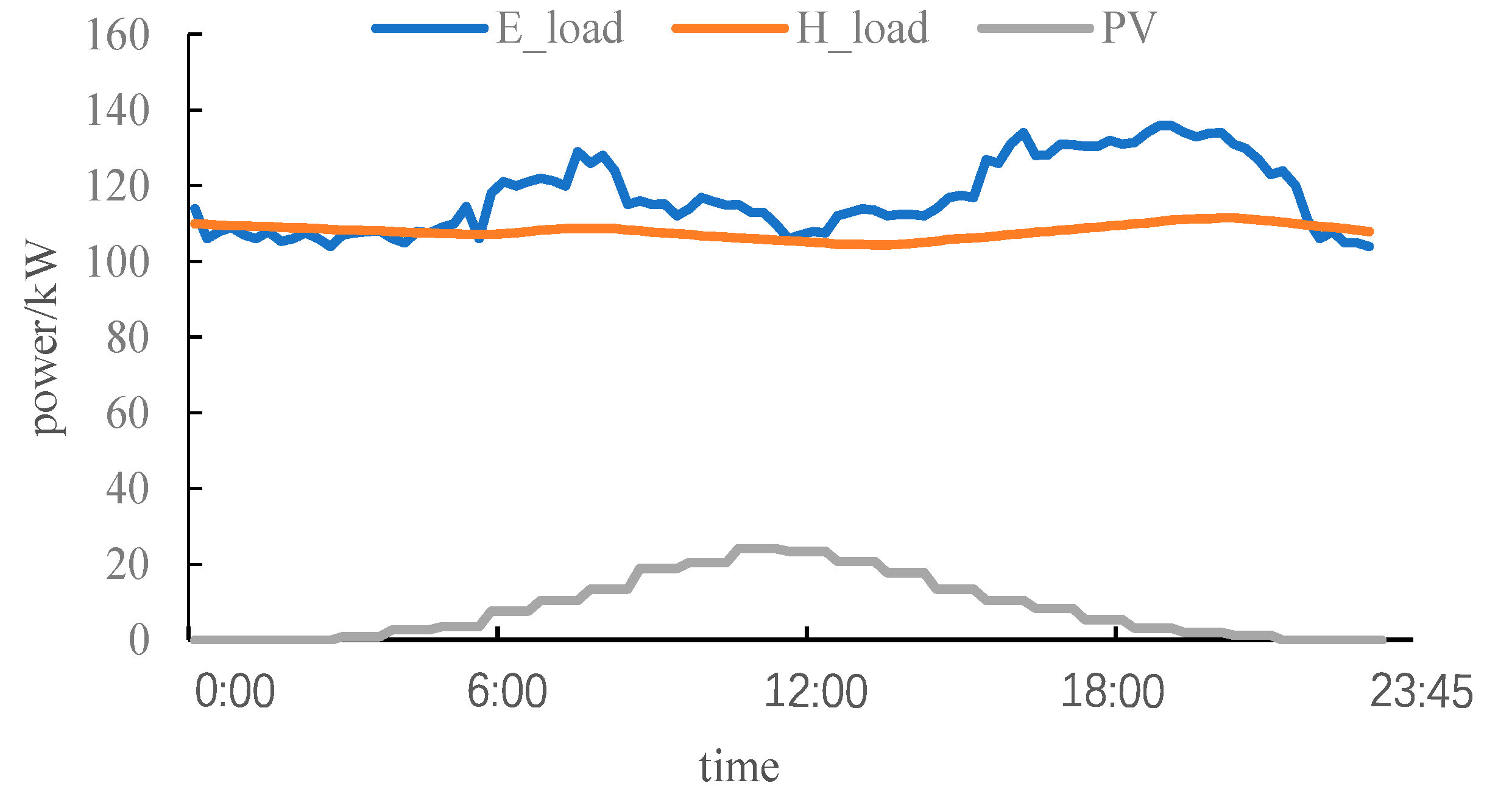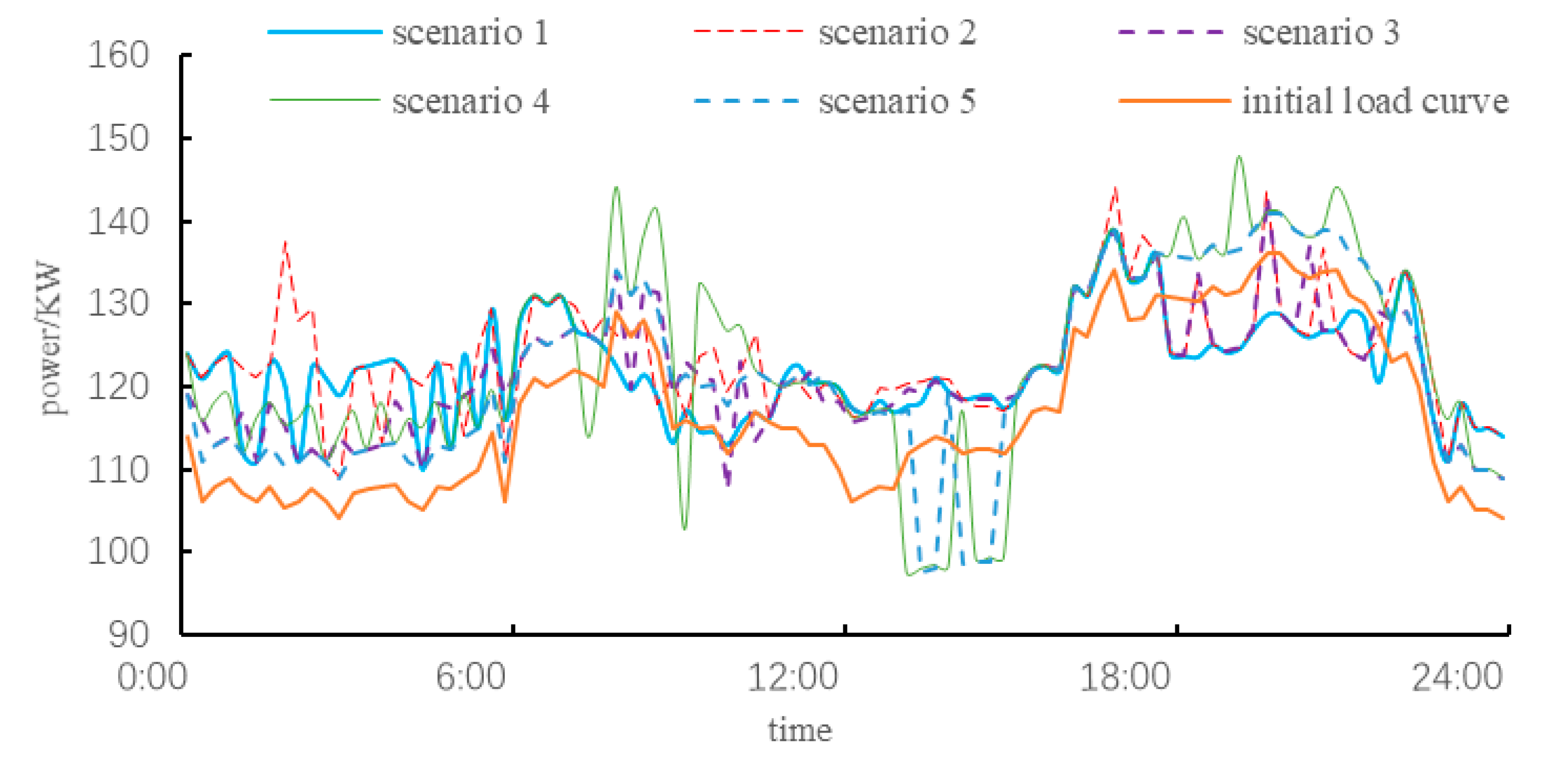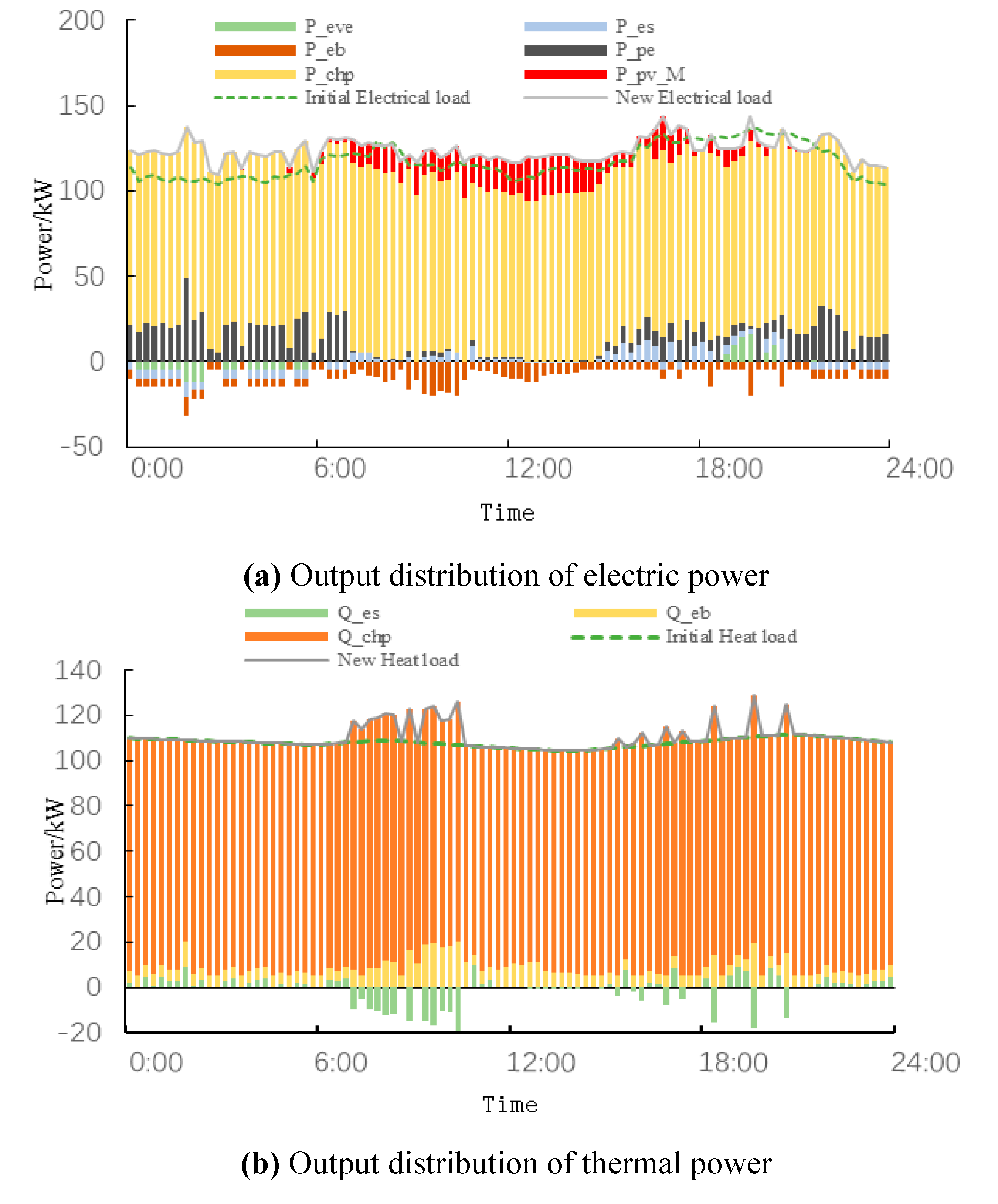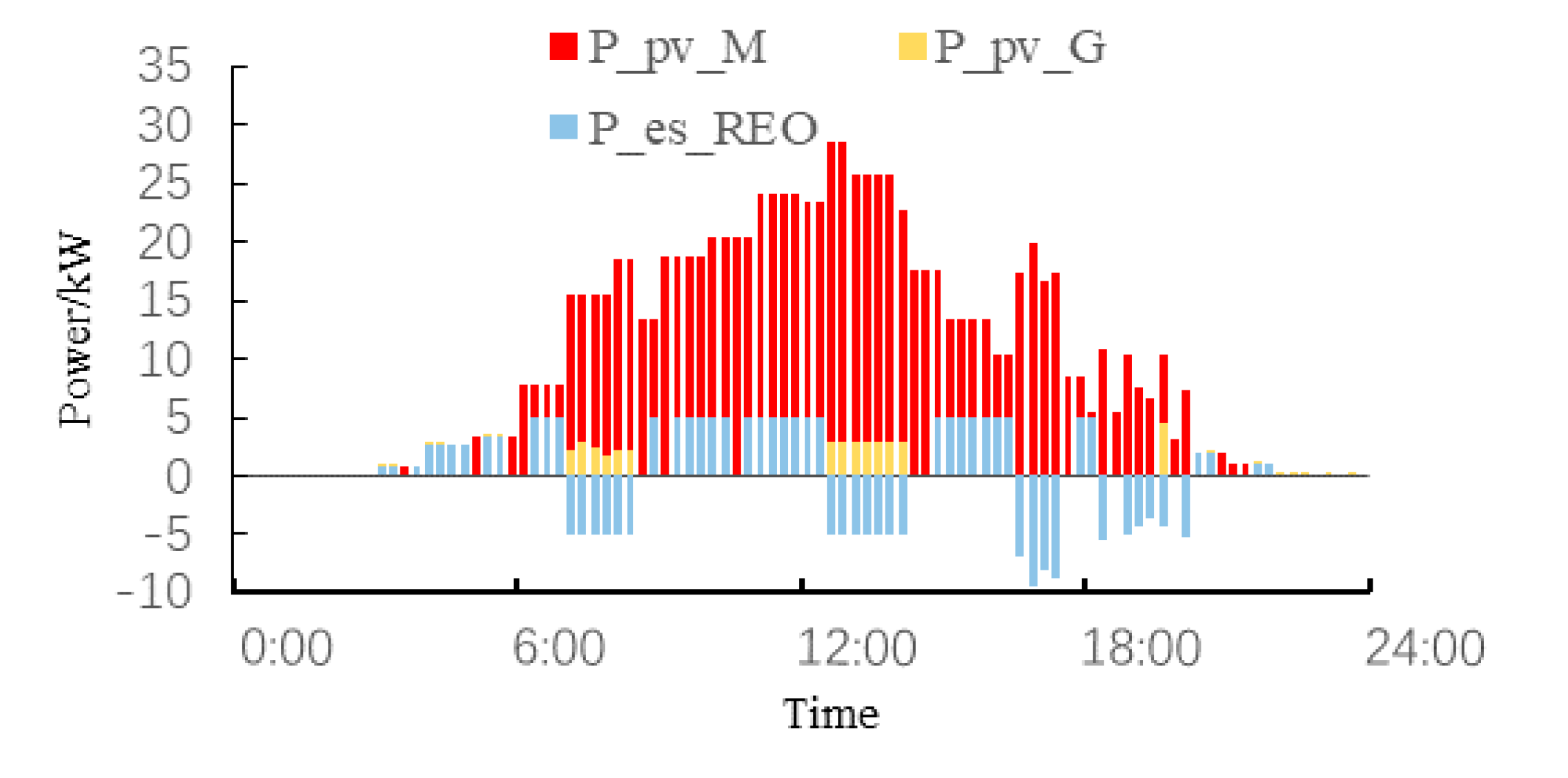1. Introduction
In a contemporary world, which is undergoing drastic development of the energy internet and an increasing connection of energy sources, such as electricity, heat, and cooling, clean and efficient use of energy has gradually become the focus of attention [
1]. How to develop energy in ecofriendly way and accelerate the energy transition and improve energy utilization is an urgent problem to be solved. Comprehensive utilization of cooling, heat, electricity, and gas provide new ideas for energy development, and the development of Internet of Things and wide-area communication technology provide convenience for energy integration, coordination planning, and energy supply optimization [
2,
3]. Based on the combined cooling heating and power (CCHP), the integrated energy system (IES) can improve the utilization efficiency of integrated energy and reduce environmental pollution through the cascade utilization of energy [
4].
Research on integrated energy systems is actively carried out, with an emphasis on the optimization dispatch and system planning of integrated energy systems [
5,
6,
7,
8]. The authors of [
5] proposed an integrated electrical and natural gas system, including wind turbines, cogeneration, and gas supply equipment. With the goal of minimizing operation costs, an optimal dispatch strategy was established; the authors of [
6], aiming at solving the problem of the large-scale wind curtailment and poor dispatch economy, established a day-ahead economic dispatch model for a regional power-heat integrated energy system. The proposed model and algorithm analyze the action of each unit in economic dispatch and wind-power accommodation effectively, verifying its efficiency and applicability; in [
7], the two-stage optimization algorithm was used to optimize the park-level integrated energy system. The upper layer is aimed at the minimum total annual cost, annual pollution emission, and annual energy consumption, and the lower layer is aimed at the lowest operation and maintenance cost, which can effectively increase the overall benefit of the system. The authors of [
8] established an integrated energy model for multi-energy complementary and coordinated development, proposed a distribution network planning strategy based on integrated energy system optimization, and looked to the future of integrated energy systems across regions.
The ETH Zurich Institute first proposed the concept of an energy hub (EH) in the “Future Energy Network Vision” project in 2007 [
9]. An energy hub is defined as an input-output port model that describes the exchange and coupling relationships between energy, load, and networks in a multi-energy system. The coupling matrix plays an important role in the planning and operation of multi-energy systems as it can briefly represent the various coupling relationships, such as transformation, storage, and transmission between electric, heat, and cooling [
10,
11]. As demand response technology plays an important role in promoting operational efficiency of the power system, the optimization dispatch model of integrated energy considering demand response technology is a continuous improvement [
12,
13]. Based the decentralized load-side demand response structure, some scholars proposed integrated demand response technology, which can improve the utilization of various equipment in the energy hub [
14].
Though the above references have made some progress in the study of IESs, there are several factors that have not been considered: (a) In fact, since the devices in the IES are not owned by the same agent, each agent will not sacrifice their own benefits for the sake of the global optimum. It is important to construct a multi-agent model of integrated energy and establish a trading mechanism between the various agents for integrated energy development; (b) in an integrated energy system, there is lots of waste energy, such as residual heating and cooling. If they were recycled, it would further reduce the operation cost of the system. (c) Although the energy hub technology has been mentioned, a few references took this technology into consideration in integrated energy system dispatch and planning research.
In summary, according to the attributes and functions of the devices, this paper divides the IES into three main agents: The integrated energy service provider (IESP), renewable energy owner (REO), and users, respectively; secondly, the mathematical model of energy hub technologies, like integrated demand response, electricity storage, and thermal storage, are established, and the electric vehicle response model is introduced. From the perspective of balancing the multi-agent’s interest, the multi-agent’s optimization dispatch model is proposed, and solved by the NSGA-III, which can get the pareto optimal frontier. Furthermore, since the Pareto frontier is a series of values, the optimal solution of each agent in the Pareto frontier is found by the TOPSIS. Through the simulation, the load curve and the economic benefits of each agent are obtained under different scenarios, and the equipment output considering various technologies of the energy hub is analyzed in detail to illustrate the validity and practicability of the model.
The remaining sections of this paper are as follows:
Section 2 describes the integrated energy hub technology. The integrated energy multi-agent model of IES is constructed in
Section 3.
Section 4 introduces the model solution. A case study and results analysis are given in
Section 5. Finally,
Section 6 draws the conclusion.
4. Model Solution
The dispatch model of IES considering multi-agent’s benefit balance can be described as:
where
hi(
x) and
gi(
x) represent the equality and inequality constraints of the model, respectively;
x is the vector of decision variables of all time periods.
The goal of this model is to balance the interests of the three main agents: IESP, REO, and users. It is known from Equation (23) that it is a common multi-objective optimization problem. The NSGA algorithm is currently a common algorithm to solve multi-objective problems. Since the introduction of the NSGA algorithm by Deb, it has undergone three generations of reforms. At present, the NSGA-II algorithm [
27,
28] is widely used. The NSGA-II algorithm uses the crowding distance method and the elite strategy to sort, which can effectively ensure the diversity of the population, reduce the computational complexity, and accelerate the Pareto frontier convergence. However, when solving multi-objective problems with more than two objective functions, its computation becomes inefficient and prone to a local optimum. Compared with the previous two generations, the NSGA-III algorithm has improved the selection mechanism. Through introducing the reference point selection and normalization method [
29,
30], the multi-objective problem of more than two objective functions can be effectively solved. The flowchart is shown in
Figure 2.
The difference between NSGA-III and NSGA-II lies in the selection mechanism of the parent population. The selection steps of NSGA-III are as follows:
Step 1: Find the minimum of all targets from the new group, R, and define it as
, which is the ideal point of the objective function, and transform the objective function by Equation (24):
Step 2: Construct a hyper plane. The general intercept formula of the hyper plane is:
where
ai is intercept between the hyper plane and axis of each dimension, which can be obtained by the extreme point calculation method. The solution formula of extreme points is shown in Equation (26):
where M is the number of objective functions, and
wi is the weight coefficient. When a dimension weight coefficient is set to 1, the other dimension weight coefficients are 10
−6 (infinitesimal close to 0).
Step 3: Based on the hyper plane constructed in step 2, each individual in the population,
R, can be normalized to:
Step 4: The projection distance of each individual in the population,
R, on the hyper plane after normalization can be expressed as:
In the formula, the smaller the value of
d1(
u), the better the convergence of the individual,
u.
Step 5: The crowded distances of each projection point are evaluated by the modified Harmonic mean distance method [
31], shown in Equation (29):
where
K is the square root of the population size, represents the distance between the individual,
u, and the
Kth nearest individual. The larger the value of
d2(
u), the better the distribution of the individual,
u.
Step 6: Synthesize the convergence and distribution characteristics of the population in the hyper plane, and select the new group R by the selection formula:
where
is the penalty factor used to balance the proportions of convergence and distribution, when the value of
D(
u) is smaller, the individual,
u, is more likely to be selected into the parent population.
The steps for solving the proposed model using the NSGA-III algorithm are as follows:
Step 1: Input the raw data, including the energy supply and storage equipment parameters, in IESP, the typical daily load curve, integrated demand response parameters, and constraints. Initialize the NSGA-III algorithm parameters: Set the population size to 100, the number of iterations to 50, the crossover probability to 0.8, the probability of variation to 0.2, and Pareto optimal individual coefficient to 0.5.
Step 2: Form the initial population and encode the output of each equipment as the set {X1, X2, …, Xn}. The transaction prices between the agents are represented by XI2U, XR2I, and XR2U, respectively;
Step 3: According to the proposed NSGA-III algorithm, select, cross, and mutate the populations to form a new sub-group, and each dimension of each individual should meet the constraints in the process of selecting, crossing, and mutation.
Step 4: If the number of iterations is reached, generate a Pareto frontier; otherwise, return to step 3.
Step 5: As the Pareto frontier is a series of values, the optimal solution from the frontier of Pareto can be found using the TOPSIS method [
32,
33], obtaining the optimal dispatch scheme.
5. Results and Discussion
Taking an integrated energy demonstration park in China as an example, the typical daily thermoelectric load and photovoltaic output curve in the park are shown in
Figure 3. The cogeneration in this park adopts the “heat-deciding power generation” mode for heating. The renewable energy is mainly based on photovoltaic (PV) and is equipped with 2 × 20 kW distributed photovoltaic units. The cooling load in the park is mainly the air-conditioning load, and this paper turns it into electrical load considerations. The price of gas in the park is 2.93 ¥/m
3. The simulation divides the day into 96 time periods with the interval of 15 minutes.
The parameters of the power supply and heating equipment are shown in
Table 1, where
ki is the constant of unit power operation and maintenance.
Table 2 shows the electricity price purchased by the park from the grid (X
G2I) and the price of PV sold to the grid (X
R2G) during the peak, flat, and valley period. The peak period is 8:00–11:00, 18:00–22:00; the flat period is 11:00–18:00 and 22:00–23:00; the valley period is 00:00–8:00 and 23:00–24:00.
5.1. Comparative Analysis of Different Scenarios
To illustrate the role of energy hub technology in integrated energy dispatch, the following five scenarios are used to simulate the thermoelectrical power output of the IESP and the overall revenue of each agent:
Scenario 1: The integrated demand response taking into account in the system, both the power storage and thermal storage included in the IESP.
Scenario 2: The integrated demand response taking into account in the system, the power storage included in the IESP, without the thermal storage;
Scenario 3: The integrated demand response taking into account in the system, the thermal storage included in the IESP, without the power storage.
Scenario 4: The integrated demand response not taking into account in the system, both the power storage and thermal storage included in the IESP.
Scenario 5: The integrated demand response not taking into account in the system; neither the power storage nor thermal storage are included in the IESP.
Using the NSGA-III algorithm to solve the integrated energy of the park in different scenarios, the load curve in different scenarios is shown in
Figure 4, and the variance of the load curve in each scenario is shown in
Table 3. Combined with
Figure 4 and
Table 3, it can be seen that when the integrated demand response is taken into account, there is an obvious peak-shaving effect. When the IESP contains energy storage devices, the overall variance of the daily load curve is 37.84 (scenario 1). In the same condition, the variance of the daily load curve is 118.78 without the integrated demand response in the system (scenario 4), which is not conducive to the joint output distribution of each generator unit due to the large volatility.
Table 4 shows the economic benefits of each agent in the integrated energy system in different scenarios. From
Table 4, it can be seen that the net income of the IESP under the integrated demand response scenario (scenario 1, scenario 2, and scenario 3) is significantly more than the scenario that does not take into account the integrated demand response (scenario 4, scenario 5). Comparing scenario 1 and scenario 4, the net income of scenario 1 is 312.48 yuan more than scenario 4, which does not take the integrated demand response into consideration, while the user energy cost is also relatively low. This shows that the integrated demand response can effectively improve the economics of integrated energy dispatch.
Comparing scenario 1 and scenario 2, in the absence of thermal storage, more thermal is needed to be provided by the CHP to maintain the thermal load balance. Since the CHP operates in the “heat-deciding power generation” mode, the IESP purchases less electricity from the grid and renewable energy owners. Thus, the net income of REO is reduced without the thermal storage.
Since the power storage can adjust the charging and discharging strategy based on the load curve, the power is stored during the valley load period and released during the peak load period, which makes the combined output of each unit more reasonable as well as cuts peaks and fills valleys effectively. Comparing the load curve and the income situation of scenario 1 and scenario 3, it can be seen that in the absence of a power storage device, the load curve fluctuates severely, the net income of the IESP decreases, and the users’ energy consumption cost also increases.
5.2. Analysis of Optimization Dispatch Results
Considering the integrated demand response and game mechanism of the multi-agent’s interest, the pricing table of the trading mechanism between the IESP, REO, and the users in the park is shown in
Table 5.
Comparing
Table 2 and
Table 5, it can be seen that the electricity price sold by REO to IESP is higher than that sold by REO to the grid in each period, and lower than the electricity price purchased by the IESP to the grid, which promotes the internal consumption of renewables in the park and the economics of the IESP. In the bilateral transaction between IESP and users, IESP sells electricity to users at a lower price than the grid, which reduces the energy cost of users. Users are also more inclined to purchase energy from IESP to promote the balance of interests of all agents.
The output distribution of each unit of IESP is shown in
Figure 5. During the peak period of the electric load, there is a large disparity between the electric and thermal load. Since CHP operates in the “heat-deciding power generation” mode, the thermal output of CHP is increased to meet the electric load balance. If there is no thermal storage, it will lead to abandonment of thermal energy. The thermal energy recovered by the thermal storage can be used for cooling, as well as for heating for the rest of the time, reducing the gas cost and the output of the CHP during the valley period. Boiler heating leads to an increase in the electrical load curve, but under the combined action of an integrated demand response, energy storage, and electric vehicle, the peak and valley difference of the new load curve is reduced, and the increase of the load curve at 11:00 to 13:00 is beneficial to the output of photovoltaic units.
The time for the electric vehicle to participate in the dispatch is between 19:00 and 6:00 the next day. Through the optimal dispatch, the EVO chooses to discharge during the peak period of the electricity price, and charge during the valley period of the electricity price to maximize the net income. Meanwhile, the EVO electricity discharge price is 0.8981 ¥/kWh, less than the electricity price purchased by the IESP to the grid, reducing the operating costs of the IESP.
The REO’s output distribution is shown in
Figure 6. he internal photovoltaic consumption rate of the integrated energy system is as high as 93.69%. As illustrated in
Figure 5, in the photovoltaic sufficient moment, IESP’s power supply mainly comes from CHP and is purchased from REO. The purchase power from the grid is almost 0, which effectively reduces the operating costs of IESP. The energy storage system is configured in the REO, which discharges during the peak load period and stores excess power from the photovoltaic system during the valley load period, increasing REO’s solar energy utilization rate. The time-shift characteristic of the energy storage system makes it possible for REO to sell electricity to the IESP during peak hours (18:00–21:00) in the case of insufficient solar energy, which increases the economic benefits of REO.
5.3. Comparison with Other Dispatch Methods
The authors of [
6] introduced a global unified scheduling strategy for IES, including thermoelectric energy storage, renewable energy, and electric vehicles, which is similar to the system structure of this paper but did not consider multi-agent interest balance and energy hub technology in its process of dispatch.
Table 6 compares the various costs, benefits, and PV consumption rates of the multi-agent interest-balanced dispatch model in this paper and the global unified dispatch model proposed in [
6]. Compared with the strategy proposed in [
6], the strategies proposed in this paper are better than the strategies proposed in [
6] in the aspects of the costs of electricity purchase, gas purchase, and environmental pollution in the park. Since energy storage plays an important role in multi-agent dispatch, the loss cost is higher, but the value is not large. Under the balancing dispatch, the user’s energy cost is reduced, and the local consumption rate of PV is improved, which illustrates the effectiveness and practicability of the dispatch method to balance the multi-agent’s interest in the park.
6. Conclusions
In this paper, an integrated energy multi-agent model was constructed. With the goal of balancing the interests of all agents, integrated energy hub technology was introduced. Using the NSGA-III algorithm to coordinate the output distribution of each generator unit, the following conclusions were obtained:
(a) The system was divided into three main agents: IESP, REO, and EVO, which is more in line with the actual situation. By optimizing the dispatch to balance the interests, all agents should become the focus of integrated energy optimization dispatch.
(b) The introduction of energy hub technologies, such as integrated demand response, electricity storage, and thermal storage, can effectively reduce the operation cost of the system through the timing shift of energy. In the study of this paper, the operation cost of the system was reduced by 8.1%.
(c) The model was solved by NSGA-III algorithm to get the Pareto frontier, and the optimal optimization dispatch in the Pareto frontier was found by the TOPSIS method. The results in this paper show the effectiveness of the proposed algorithm.
This paper comprehensively considered the interests of each agent in a single park. The integrated energy system dispatch method considering multi-agents’ interests and energy hub technology can effectively improve the flexibility of the cogeneration system and make the power market more transparent and orderly. It can be applied in real life by using the method to optimize the dispatch of park-level integrated energy, through coordinating multiple stakeholders, and guiding the operation of each unit to achieve the goal of balancing interests.
This paper divided the integrated energy system into three agents: IESP, REO, and users. However, the division of multi-agents may not be the same in other parks, and how to divide each agent accurately should be based on actual conditions. On the other hand, the integrated energy interconnection between parks will become the development trend in future integrated energy systems. How to coordinate the planning and dispatch of integrated energy systems between parks will become the focus of future research.
